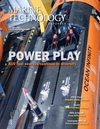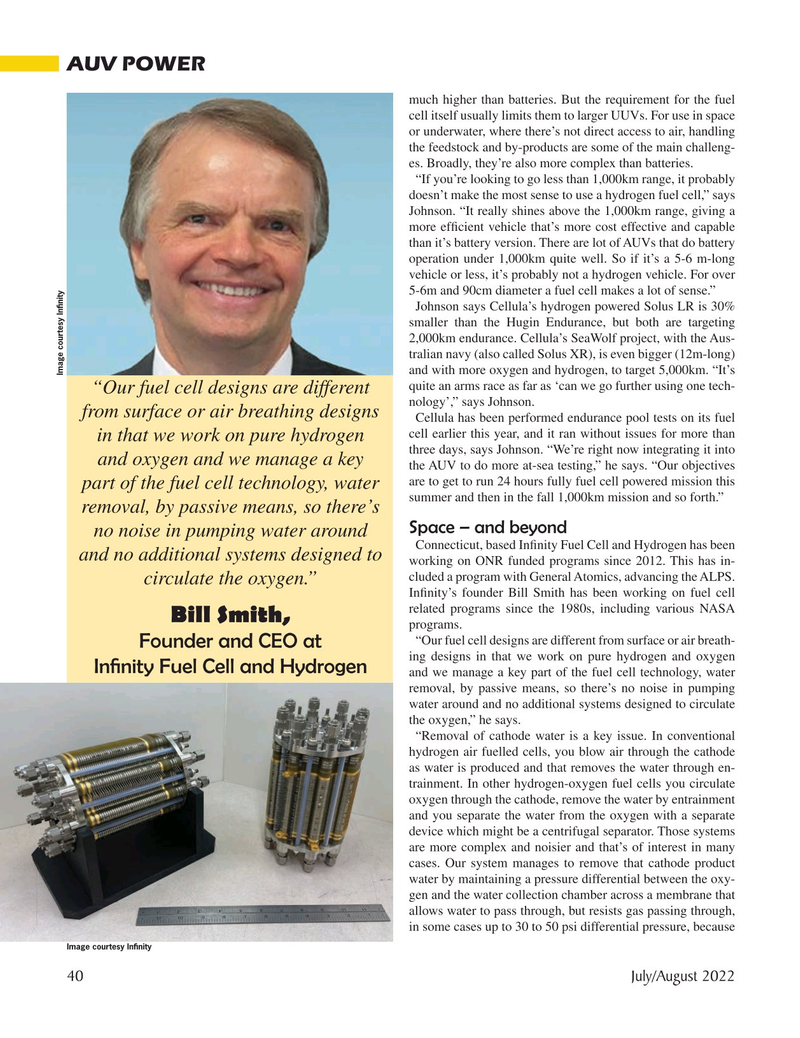
Page 40: of Marine Technology Magazine (July 2022)
Read this page in Pdf, Flash or Html5 edition of July 2022 Marine Technology Magazine
AUV POWER much higher than batteries. But the requirement for the fuel cell itself usually limits them to larger UUVs. For use in space or underwater, where there’s not direct access to air, handling the feedstock and by-products are some of the main challeng- es. Broadly, they’re also more complex than batteries.
“If you’re looking to go less than 1,000km range, it probably doesn’t make the most sense to use a hydrogen fuel cell,” says
Johnson. “It really shines above the 1,000km range, giving a more ef? cient vehicle that’s more cost effective and capable than it’s battery version. There are lot of AUVs that do battery operation under 1,000km quite well. So if it’s a 5-6 m-long vehicle or less, it’s probably not a hydrogen vehicle. For over 5-6m and 90cm diameter a fuel cell makes a lot of sense.”
Johnson says Cellula’s hydrogen powered Solus LR is 30% smaller than the Hugin Endurance, but both are targeting 2,000km endurance. Cellula’s SeaWolf project, with the Aus- tralian navy (also called Solus XR), is even bigger (12m-long) and with more oxygen and hydrogen, to target 5,000km. “It’s
Image courtesy In? nity quite an arms race as far as ‘can we go further using one tech- “Our fuel cell designs are different nology’,” says Johnson. from surface or air breathing designs
Cellula has been performed endurance pool tests on its fuel cell earlier this year, and it ran without issues for more than in that we work on pure hydrogen three days, says Johnson. “We’re right now integrating it into and oxygen and we manage a key the AUV to do more at-sea testing,” he says. “Our objectives are to get to run 24 hours fully fuel cell powered mission this part of the fuel cell technology, water summer and then in the fall 1,000km mission and so forth.” removal, by passive means, so there’s
Space – and beyond no noise in pumping water around
Connecticut, based In? nity Fuel Cell and Hydrogen has been and no additional systems designed to working on ONR funded programs since 2012. This has in- cluded a program with General Atomics, advancing the ALPS. circulate the oxygen.”
In? nity’s founder Bill Smith has been working on fuel cell related programs since the 1980s, including various NASA
Bill Smith, programs. “Our fuel cell designs are different from surface or air breath-
Founder and CEO at ing designs in that we work on pure hydrogen and oxygen
In? nity Fuel Cell and Hydrogen and we manage a key part of the fuel cell technology, water removal, by passive means, so there’s no noise in pumping water around and no additional systems designed to circulate the oxygen,” he says. “Removal of cathode water is a key issue. In conventional hydrogen air fuelled cells, you blow air through the cathode as water is produced and that removes the water through en- trainment. In other hydrogen-oxygen fuel cells you circulate oxygen through the cathode, remove the water by entrainment and you separate the water from the oxygen with a separate device which might be a centrifugal separator. Those systems are more complex and noisier and that’s of interest in many cases. Our system manages to remove that cathode product water by maintaining a pressure differential between the oxy- gen and the water collection chamber across a membrane that allows water to pass through, but resists gas passing through, in some cases up to 30 to 50 psi differential pressure, because
Image courtesy In? nity 40 July/August 2022
MTR #5 (34-49).indd 40 7/1/2022 7:51:16 AM

 39
39

 41
41
